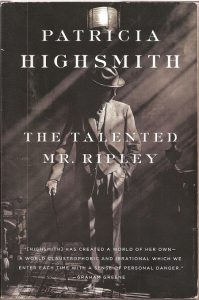
Author Patricia Highsmith (Image Source)
Patricia Highsmith is recognized today as one of the chief proponents of the paranoia thriller, and The Talented Mr. Ripley is a prime example of her fine work. Published in 1955, Ripley has proven itself to be an enduring novel: it is still in print, and still widely read, and over forty years after its publication Ripley was adapted into a blockbuster film.
The Talented Mr. Ripley introduces the character of Tom Ripley, a charming, paranoid young psychopath with a dark history. Tom is approached in Manhattan by businessman Herbert Greenleaf, who asks Tom to travel to Italy and convince his son, Dickie Greenleaf, to return to the U.S. Tom, however, has no intention of retrieving Dickie, and instead falls wildly in love with his glamorous, almost avant garde lifestyle. Tom is also intrigued by Dickie’s companion, and potentially lover, Marge Sherwood. He is enraged at Dickie’s unkind, careless treatment of her, and is disturbed that Marge does not seem to appreciate his presence. After pushing Marge’s mistrust a little too far, Tom convinces Dickie to run away with him to Rome for a time. While there, he begins to feel Dickie may be growing bored with him: he crafts a careful plan to ensure he will always be able to stay with Dickie. What follows includes, but is not limited to, feverish murders, intricate deceptions, and – pervading it all – paranoia.

2008 Paperback Cover of The Talented Mr. Ripley (Image Source)
Highsmith’s literary talents are manifold, and Ripley showcases them beautifully. Her prose, though simple, is not without elegance. She creates a world that is real, a world that is dark without being black. No, Highsmith’s world is not black – not by any means. Her world is grey, and that is another talent of hers. Morals become relative in Highsmith’s world. Tom Ripley is a murderer. He lies about the murders he commits – as a matter of fact, Tom lies about nearly everything. He witnesses the pain and heartbreak he causes others and seemingly feels no remorse. Yet Tom is likable. Highsmith throws any kind of moral center out the window, leaving the reader no choice but to gravitate towards Tom as a sort of anchor. His morals slowly become the reader’s. His reasoning for committing horrific acts gradually becomes acceptable. Highsmith paints in one color: grey. And Tom Ripley lives his life in a grey, moral-less world.
Highsmith also crafts a powerful, almost suffocating atmosphere of paranoia. One of the joys of Ripley is that the reader never actually glimpses inside Tom’s head. Instead, Highsmith keeps her readers on the fringe of Tom’s thought process, just close enough to know what he’s thinking without actually being able to see it clearly. Just as the reader slowly gravitates towards Tom as a makeshift moral center, the reader also begins to sympathize with Tom’s paranoia. By the novel’s close, that paranoia has reached a fever pitch: Tom cannot make a single move without nervously imagining (or hallucinating) his carefully constructed world of lies crumbling to the ground. Fellow paranoia-thriller-author Graham Greene said that Highsmith “has created a world of her own—a world claustrophobic and irrational which we enter each time with a sense of personal danger” (Greene).

Plein Soleil (Image Source)
Highsmith was nominated for three Edgar Awards by the Mystery Writers of America, and Ripley was one of them. The novel was successful enough to spawn an entire series of Ripley novels, though interestingly enough the follow-up to Ripley was not published until fifteen years after the original.
Ripley has also spawned a number of film, TV, and even radio adaptations. The best of these is the 1960 French film Plein Soleil (Purple Noon) – a very faithful, brilliantly-executed adaptation. The late Anthony Minghella also made a Ripley film; his was commercially successful but ultimately failed as an adaptation, changing too much of the substance of Highsmith’s plot.
Patricia Highsmith was one of the great paranoia writers, and The Talented Mr. Ripley is her finest work. Her influence can be seen in novels such as Gone Girl. She was a proponent in popularizing the anti-detective figure, through her creation of the charming, volatile Tom Ripley. Due to its well-crafted plot, realistic and compelling characters, and Highsmith’s athletic, elegant prose, The Talented Mr. Ripley transcends mere genre fiction and aspires to – if not attains – the status of literature. Overall, The Talented Mr. Ripley is a chilling, deceptive, yet enjoyable novel.
Sources & Further Reading
Dool, Jen. “The Bizarre True Story Behind the Talented Mr. Ripley.” Mental Floss, 10/21/2017. https://mentalfloss.atavist.com/the-bizarre-true-story-behind-the-talented-mr-ripley
Highsmith, Patricia. The Talented Mr. Ripley. W.W. Norton, 2008.
“Patricia Highsmith.” Biography.com, 11/28/2017. https://www.biography.com/people/patricia-highsmith-121715
Schenkar, Joan. “10 Best Patricia Highsmith Books.” Publisher’s Weekly, 11/28/2017. https://www.publishersweekly.com/pw/by-topic/industry-news/tip-sheet/article/63724-10-best-patricia-highsmith-books.html
